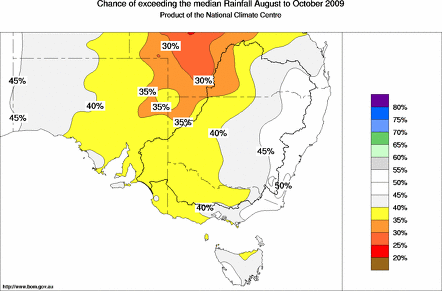| Southeastern Aust Seasonal Rainfall Outlook: probabilities for August to October 2009, issued 24th July 2009 | |||||||||
Drier conditions favoured in SA, Victoria and NSWFor southeastern Australia, the outlook for total rainfall between August and October shows a moderate shift in the odds favouring drier conditions over eastern SA, western NSW, western Victoria and northern Tasmania. The remainder of southeast Australia shows no strong shift favouring either wetter or drier conditions. The pattern of seasonal rainfall odds across southeast Australia is a result of recent warm conditions in the Indian Ocean and warming in the Pacific, with the Pacific influence being dominant. An El Niño event looks to be developing across the Pacific - a situation which often results in drier than average conditions across the Murray-Darling Basin, southern Victoria, eastern Tasmania and eastern SA (for more information see below). 
For the August to October period, the chance of exceeding median rainfall is between 30 and 40% in a broad area extending over the eastern half of SA, far western NSW, the western half of Victoria and into northern Tasmania (see map). This means that for every ten years with ocean patterns like the current, about three or four years would be expected to be wetter than average in these parts of southeastern Australia during this three-month period, with about six or seven being drier. Over most remaining parts of the southeast, the chance of a wetter than average season is between 40 and 50%. In other words the chances of above normal falls are about the same as the chances of below normal. New: An expanded set of seasonal rainfall outlook maps and tables, including the probabilities of seasonal rainfall exceeding given totals (e.g. 200 mm), is available on the "Water and the Land" (WATL) part of the Bureau's website. Outlook confidence is related to how consistently the Pacific and Indian Oceans affect Australian rainfall. During August to October, history shows that confidence to be moderately consistent over northern inland NSW, central and western Victoria, parts of northern and southeastern SA, and northeastern Tasmania (see background information). Over remaining parts of southeastern Australia, the effect is only weakly to very weakly consistent: Caution should be used when interpreting the outlook in these areas. An El Niño event looks to be developing across the Pacific: the latest outputs from computer models indicate it will reach peak intensity late in the year. El Niño events are usually (but not always) associated with below normal rainfall in the second half of the year across large parts of southern and inland eastern Australia. The SOI is approximately +11 for the 30 days ending 21 July. For routine updates and comprehensive discussion on any developments please see the ENSO Wrap-Up. | |||||||||
Click on the map above for a larger version of the map. Use the reload/refresh button to ensure the latest forecast map is displayed. More detailed forecast maps, including the probabilities of seasonal rainfall exceeding given totals, can be found here. | |||||||||
|
More information on this outlook is available Monday to Friday from 9.00am to 5.00pm local time by contacting the Bureau's Climate Services sections in Queensland, NSW, SA, Victoria and Tasmania at the following numbers:
| |||||||||
THE NEXT ISSUE OF THE SEASONAL OUTLOOK IS EXPECTED BY 26th August 2009 Corresponding temperature outlook | |||||||||
Background Information
| |||||||||









